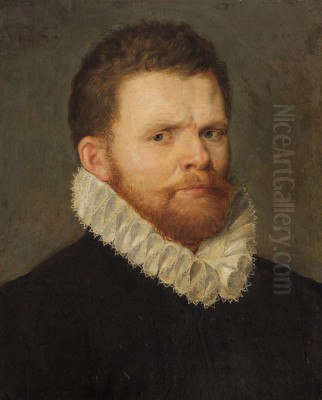
Gillis Mostaert the Elder stands as a significant figure in the bustling art scene of 16th-century Antwerp. Born around 1528 (or possibly 1534, sources vary slightly) in Hulst, in the Duchy of Brabant (now in the Netherlands), he passed away in Antwerp on December 28, 1598. He was a prolific Flemish Renaissance painter known for his versatility, producing landscapes, genre scenes, and religious subjects that vividly capture the spirit and daily life of his time. He operated a large workshop, contributing significantly to the diverse artistic output of Antwerp during its golden age.
Early Life and Artistic Formation
Gillis Mostaert hailed from an artistic family. He was the twin brother of Frans Mostaert, who also became a respected landscape painter. While definitive lineage is debated, they may have been related to the earlier, highly regarded Haarlem painter Jan Mostaert (c. 1475–1555/1556), though the exact connection remains unclear. It is crucial to distinguish Gillis Mostaert of Antwerp from Jan Mostaert of Haarlem, as their careers and biographical details are sometimes confused in older literature.
According to the early art historian Karel van Mander (1604), both Gillis and his brother Frans studied painting in Antwerp under Herri met de Bles. However, this apprenticeship is now considered unlikely due to the age difference and Bles's own periods away from Antwerp. Modern scholarship suggests Gillis may have trained under Jan Mandijn, a painter known for his imaginative, Bosch-like scenes, which could explain some of the fantastical elements, particularly fire scenes, found in Gillis's later work. Regardless of his specific master, Gillis absorbed the techniques and trends prevalent in Antwerp. He was admitted as a master in the Antwerp Guild of Saint Luke in the guild year 1554–1555.
Antwerp: A Thriving Metropolis and Artistic Hub
Mostaert established his life and career in Antwerp, the vibrant commercial and cultural heart of the Low Countries in the mid-16th century. The city's wealth attracted artists, patrons, and merchants, fostering a competitive and innovative art market. Mostaert married Margareta Baes in 1563, and the couple had six children. He set up a substantial workshop, likely employing assistants and apprentices to meet the demand for his paintings, which ranged from small cabinet pieces to larger compositions.
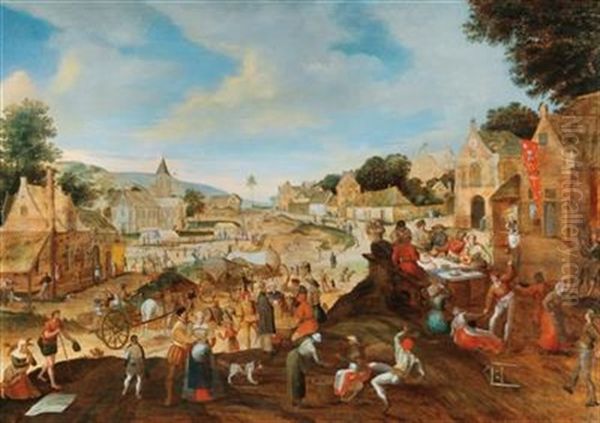
His presence in Antwerp placed him amidst a generation of highly skilled painters. He was a contemporary of figures like Pieter Bruegel the Elder, whose peasant scenes clearly influenced Mostaert's own depictions of village life. Other notable Antwerp artists active during his lifetime included Pieter Aertsen and his nephew Joachim Beuckelaer, known for their market and kitchen scenes, the landscape painters Jacob Grimmer and Cornelis van Dalem, and the prolific Francken dynasty, particularly Frans Francken the Elder. This rich artistic environment fostered both competition and collaboration.
Artistic Style: Versatility and Observation
Gillis Mostaert was remarkably versatile. His oeuvre encompasses a wide range of subjects, reflecting the diverse tastes of the Antwerp market. His style is characterized by lively narratives, often crowded compositions, a keen eye for detail, and a vibrant, sometimes sharp, color palette. While influenced by major figures like Bruegel and Bosch, he developed a recognizable manner.
Genre Scenes: Markets, Kermesses, and Daily Life
Perhaps Mostaert's most characteristic works are his genre scenes depicting the everyday life of Flemish towns and villages. He excelled at painting bustling market squares, lively village kermesses (fairs or festivals), and scenes of peasants working or celebrating. These paintings teem with anecdotal detail, capturing the energy, chaos, and social interactions of the time. Figures are often numerous, small in scale relative to the overall setting, and depicted with expressive gestures and postures.
His market scenes, such as the Market Square in a Flemish Town, provide fascinating glimpses into contemporary commerce and urban life. Similarly, his kermesses, like Village Feast, echo the themes popularized by Pieter Bruegel the Elder, showing villagers eating, drinking, dancing, and sometimes quarreling. While lacking Bruegel's profound monumentality and psychological depth, Mostaert's scenes are engaging narratives filled with humorous or moralizing observations about human behavior.
Religious Subjects in Contemporary Settings
Mostaert also frequently painted religious subjects, but often grounded them in familiar Flemish settings. Biblical narratives like Christ Carrying the Cross, the Ecce Homo, or parables were depicted with crowds of figures dressed in contemporary attire, set against landscapes or townscapes recognizable to his audience. This approach made the sacred stories more immediate and relatable. His depictions of the Passion often emphasize the suffering of Christ amidst the indifference or cruelty of the surrounding crowd, a common theme in Northern European art of the period.
He also painted allegorical subjects and scenes from the Old Testament. Works like The Hay Wain, clearly inspired by Hieronymus Bosch's famous triptych, demonstrate his engagement with moralizing themes and earlier artistic traditions. These religious and allegorical works allowed him to explore complex narratives and incorporate symbolic elements.
Landscapes: Winter Scenes and Town Views
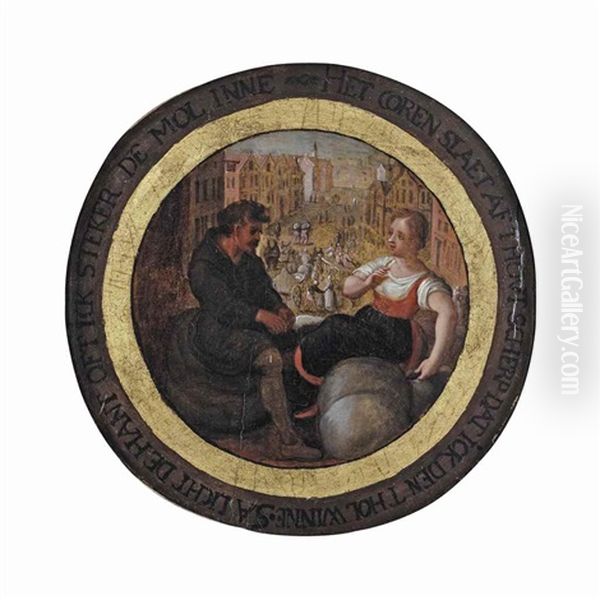
While his brother Frans specialized primarily in landscapes until his early death around 1560, Gillis also proved adept at rendering natural settings. He is particularly noted for his winter landscapes, often populated with skaters enjoying themselves on frozen rivers or canals. These scenes capture the specific atmosphere of the season and continue a tradition popular in Flemish art.
His landscapes often serve as backdrops for his genre or religious scenes, providing detailed settings that enhance the narrative. He depicted both rural countryside and views of towns, sometimes incorporating recognizable architectural elements. The meticulous rendering of landscape details contributes significantly to the overall richness of his compositions.
Nocturnes and the Fascination with Fire
A distinctive aspect of Mostaert's work is his skill in depicting night scenes, particularly those involving fire. Paintings like the Burning of Troy or various depictions of villages ablaze at night showcase his ability to handle dramatic light effects – the flickering glow of flames against deep shadows, illuminating figures and architecture. This interest in nocturnal scenes and conflagrations again links him to the imaginative tradition of Hieronymus Bosch and perhaps his presumed teacher, Jan Mandijn. These dramatic works were popular with collectors and demonstrate his technical range.
Mannerist Influences
While grounded in detailed observation, Mostaert's figure style sometimes shows the influence of Mannerism, an artistic trend that spread from Italy across Europe. This can be seen in slightly elongated proportions, elegant or sometimes contorted poses, and complex, dynamic compositions. However, he generally balanced these stylistic tendencies with the robust naturalism characteristic of Flemish painting, creating a style that was both sophisticated and accessible.
Workshop Practices and Collaborations
Like many successful Antwerp masters, Gillis Mostaert ran a large and productive workshop. This involved assistants helping with painting backgrounds, replicating popular compositions, or specializing in certain elements. This workshop practice explains the large number of paintings attributed to him and the variations in quality sometimes observed. Attribution can occasionally be challenging, distinguishing his autograph work from that of his workshop or followers.
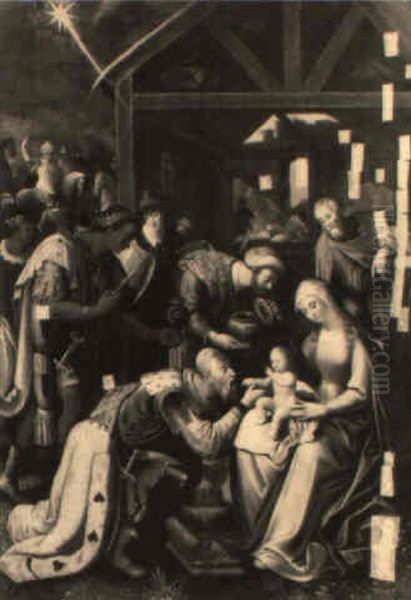
Collaboration between independent masters specializing in different areas (e.g., figures, landscapes, architecture) was common in Antwerp. Mostaert is known to have collaborated with several artists. He frequently painted the staffage (figures) in landscapes by other painters, including Cornelis van Dalem and Jacob Grimmer. Perhaps his most notable collaborator was the architectural painter Hans Vredeman de Vries. Mostaert would add the figures to Vredeman de Vries's elaborate perspectival views of palaces, gardens, and imaginary buildings, creating works that combined architectural grandeur with lively human activity. This partnership highlights the specialization prevalent in the Antwerp art market. There is also evidence suggesting he sometimes collaborated with his twin brother Frans before the latter's death.
Representative Works
Attributing specific works definitively can be complex due to workshop involvement and historical record gaps, but several paintings are widely accepted as representative of Gillis Mostaert the Elder's style and themes:
Market Square in a Flemish Town (various versions): Exemplifies his bustling urban scenes, filled with vendors, shoppers, animals, and anecdotal details.
Village Kermesse / Village Feast (various versions): Shows his debt to Bruegel and his ability to capture the boisterous energy of peasant festivals.
Christ Carrying the Cross: A typical example of his religious narratives set in a contemporary Flemish landscape, crowded with figures.
Winter Landscape with Skaters: Represents his skill in depicting seasonal atmosphere and activities.
Fire in a Village at Night / Burning of Troy: Demonstrates his mastery of nocturnal light effects and dramatic, Bosch-influenced themes.
Ecce Homo: Often depicted as a crowded scene before a detailed architectural backdrop, showcasing both religious narrative and urban setting.
The Hay Wain (attributed): Shows his engagement with Boschian allegory and moralizing subject matter.
Allegory of Commerce (collaboration, likely with Vredeman de Vries or workshop): Represents collaborative works combining figures and architecture.
These works, found in museums across Europe and North America, illustrate the breadth of his subject matter and his characteristic style.
Confusion with Contemporaries
The collaborative nature of Antwerp workshops and similarities in subject matter sometimes lead to confusion between the works of Gillis Mostaert and his contemporaries. Besides the potential mix-up with Jan Mostaert, his works, particularly genre scenes, can sometimes resemble those of Marten van Cleve or artists from the Francken family workshops, such as Frans Francken the Younger (though the latter belonged to the next generation). Careful stylistic analysis is often required for accurate attribution.
Legacy and Significance
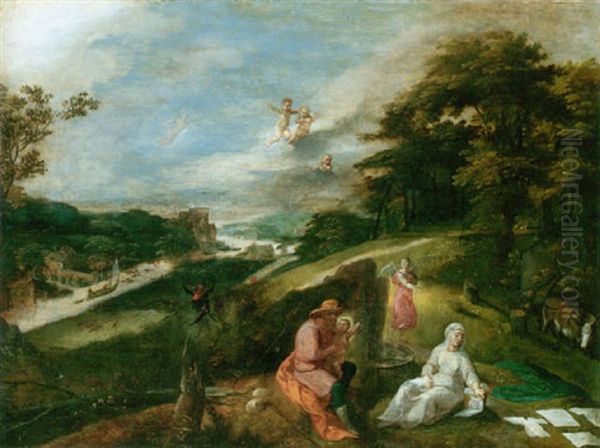
Gillis Mostaert the Elder was a highly successful and productive painter who played a vital role in Antwerp's art scene for over four decades. His success lay in his ability to cater to the diverse demands of the market, producing appealing works across various genres. He was a key figure in popularizing genre painting, capturing the vibrant life of Flanders with energy and detail. His depictions of markets, festivals, and everyday activities provide invaluable visual documentation of 16th-century society.
While perhaps overshadowed in art historical narratives by the towering genius of Pieter Bruegel the Elder, Mostaert was a significant artist in his own right. His influence can be seen in the work of later Antwerp genre painters. His collaborations, particularly with Hans Vredeman de Vries, exemplify the specialized and cooperative nature of art production in the period. His prolific output ensured his work was widely distributed, contributing significantly to the reputation of the Antwerp school.
In conclusion, Gillis Mostaert the Elder emerges as a versatile and observant chronicler of his time. Through his detailed paintings of religious subjects, landscapes, and, most notably, the bustling life of Flemish towns and villages, he offers a rich and enduring window onto the world of 16th-century Antwerp. His work remains a testament to the skill, productivity, and diverse artistic interests that characterized this golden age of Flemish painting.